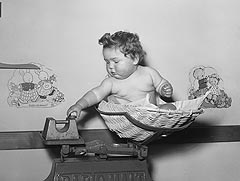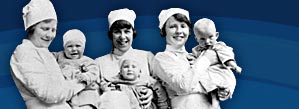A Scottish baby
“If Nye Bevan had not existed, we in Scotland would have found ourselves carried into a National Health Service just as we were in 1948.”
Ronald Fraser, Assistant Private Secretary to the Secretary of State for Scotland, 1944 -1947.
The NHS in Scotland was a very different creature to its cousin in England.
In England the baptism of fire came before the birth – Bevan using Parliamentary forceps on what threatened to be a breech delivery against concerted medical opposition.
Closer and well-established working relationships in Scotland between doctors, civil servants and universities enabled an easier birth plan. The Scottish baby was:
- a wanted child – welcomed by most sections of society with a future course set out in detail in the Cathcart Report
- created with its own distinct legal identity via a separate Act of Parliament
- almost irresistible. The voluntary hospital system was financially crippled
- already in a family with two older siblings in the Highlands and Islands Medical Service and the Emergency Hospital Service.
Administrative devolution had witnessed the growth of a civil service in Edinburgh with direct, hands-on experience of running health services. There was no equivalent in England.
The separate Scottish NHS Bill, ready early in 1946, was delayed in case it caused problems for Bevan with the Bill for England and Wales.
It was later criticised by the Scottish BMA for being a watered-down version, scarcely distinguishable from its counterpart south of the border.
But there were important differences. Scotland’s medical schools had a clear role within the new regional hospital boards. Unlike in England, they were built into the bricks of the fledgling NHS from the outset. Prime Minister Atlee preferred the Scottish model.
The public announcement
Arthur Woodburn was appointed Secretary of State for Scotland in October 1947. Talks with pharmacists about the NHS went on late one night. Woodburn was left to type out the agreement himself on an old machine he had used in his time as private secretary to Tom Johnston.
Every family received a booklet ahead of the launch. On the front was the face of a reassuring doctor and a foreword from Woodburn.
The booklet promised:
- A family doctor for every member of the home, young and old
- Medicine, drugs and medical aids on a doctor’s prescription
- Dental services, including dentures
- Hearing tests and hearing aids, if required, fitted free
- Eye tests, and free spectacles with a choice of style
- Full treatment in general and specialist hospitals either as an in-patient or an out-patient. If you need a surgical operation or a “second opinion” you will get it, and the specialist or consultant will visit you at home if that is necessary
At a time when basic items were still rationed, there were also some strings attached. Shortages of nurses, dentists and health visitors would mean no full service at the outset.
There were two critical passages in the booklet – private beds would be allowed in Scottish NHS hospitals (one of the concessions made by Bevan) and the GP health centres which were central to Cathcart’s health promoting vision would be a long time coming.
- Further information
- Your Health Service: how it will work in Scotland
- Calton Jail

Arthur Woodburn (1890-1978), was the only Secretary of State for Scotland to have known St Andrew’s House in its former role as a prison.
Imprisoned for his anti-war activities, Woodburn was transferred from Wormwood Scrubs to Calton Jail during the First World War. He described it as “the poorhouse of all prisons which had the cold chill of a grim fortress.”
Calton Jail was demolished to make way for the new headquarters of the Scottish Office. From a career-quenching backwater, it had started to attract able and enthusiastic civil servants.
The formal opening of St Andrew’s House was delayed at the outbreak of war in 1939. The jail’s original basement cells were preserved in the art deco design by leading Scottish architect Thomas Tait.
